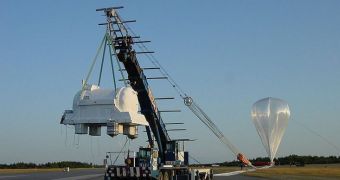An incident that took place earlier this year forced the American space agency to temporarily suspend its balloon science program, pending a full review. Now, two months after the document was released, NASA is finally comfortable with letting its balloons carry our science sorties again.
According to a press release from the agency, the program will be resumed this month, while keeping in mind all of the things that were learned the hard way this spring. The highlight of the new approach to balloon flights is a host of new security and safety processes and procedures.
Earlier this year, as NASA was attempting to launch a balloon from Australia, winds destabilized the large object, which became loose, and wondered around the launch site, dragging its payload around.
After narrowly missing some onlookers that had come to see the launch, the payload was smashed through a fence, and into a car, totaling the sensitive telescope it was supposed to take to the upper edge of Earth's atmosphere.
An extensive panel review of what went on that day found no less than 25 factors and causes that contributed to the disastrous outcome of the launch attempt, including insufficient risk analysis, contingency planning, personnel training, government oversight and public safety accommodations.
“NASA's Goddard Space Flight Center, Wallops Flight Facility, and contractor balloon team have done an outstanding job over the past eight months to develop and implement plans to return the balloons to flight,” says Jon Morse.
“We look forward to once again conducting groundbreaking science with these balloon systems,” adds the official, who is the director of the Astrophysics Division in the Science Mission Directorate at NASA Headquarters in Washington.
In order to address the recommendations made by the review panel, the space agency developed a corrective action plan. Here are some of its highlights.
· Redesigned the launch head mechanism that failed to work properly during the Australia aborted launch; · Developed plans to better respond to mishaps and close calls with respect to balloon launch operations. · Instituted NASA independent ground and flight safety roles to ensure that balloon launches are conducted safely; · Revised the safety procedures used to conduct balloon launches; · Developed a more stringent launch safety area in which the balloon launch vehicle can maneuver in order to protect the safety of the public.

 14 DAY TRIAL //
14 DAY TRIAL //